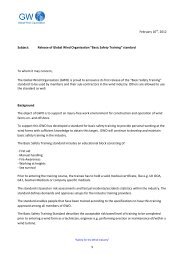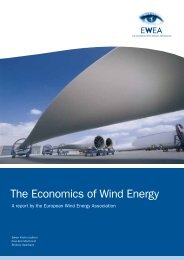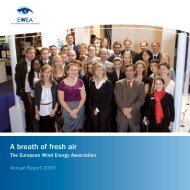Offshore Electricity Infrastructure in Europe - European Wind Energy ...
Offshore Electricity Infrastructure in Europe - European Wind Energy ...
Offshore Electricity Infrastructure in Europe - European Wind Energy ...
Create successful ePaper yourself
Turn your PDF publications into a flip-book with our unique Google optimized e-Paper software.
<strong>in</strong>troduction<br />
1.1 Context and background<br />
<strong>Europe</strong> has ambitious targets for renewable energy<br />
deployment. By 2020, 20% of gross f<strong>in</strong>al energy consumption<br />
should be met by renewable sources [19].<br />
<strong>Offshore</strong> w<strong>in</strong>d power is expected to deliver a large contribution.<br />
An <strong>in</strong>stalled capacity of 40 GW of offshore<br />
w<strong>in</strong>d power is expected <strong>in</strong> <strong>Europe</strong> by 2020, <strong>in</strong> 2030<br />
this can amount to 150 GW, of which about 126 GW<br />
will be located <strong>in</strong> Northern <strong>Europe</strong> [20].<br />
The EC 2050 Roadmap [21] fosters this development<br />
further with the long-term target to cost-efficiently reduce<br />
<strong>Europe</strong>an Greenhouse Gas emissions by 80%<br />
to 95% by 2050. This goal is only achievable with<br />
large-scale deployment of renewable energy generation<br />
with offshore w<strong>in</strong>d energy as a dom<strong>in</strong>ant<br />
generation source.<br />
Consequently, the number of w<strong>in</strong>d farms is expected<br />
to <strong>in</strong>crease rapidly with<strong>in</strong> the next decade, particularly<br />
<strong>in</strong> the North and Baltic Seas. All these w<strong>in</strong>d farms<br />
will have to be connected to onshore power systems.<br />
This raises questions on how to connect the future<br />
w<strong>in</strong>d power capacity and how to <strong>in</strong>tegrate it <strong>in</strong>to the<br />
national power systems <strong>in</strong> an efficient and secure way.<br />
The first offshore w<strong>in</strong>d farms were connected <strong>in</strong>dividually<br />
to the onshore power system. However, these w<strong>in</strong>d<br />
farms were limited <strong>in</strong> capacity and relatively close to<br />
shore. Future w<strong>in</strong>d farms may be up to several thousand<br />
MW’s, at distances of more than 200 km from<br />
shore. In particular for these w<strong>in</strong>d farms bundl<strong>in</strong>g the<br />
electric connection at sea and carry<strong>in</strong>g the energy over<br />
a jo<strong>in</strong>t connector to the onshore connection po<strong>in</strong>ts can<br />
be more efficient than <strong>in</strong>dividual connections of w<strong>in</strong>d<br />
farms to shore. This so-called hub connection design<br />
can reduce costs, space usage and environmental impact<br />
dramatically. Once these w<strong>in</strong>d farms or hubs are<br />
<strong>in</strong> place, new connection design opportunities open:<br />
The hubs can be teed-<strong>in</strong> to <strong>in</strong>terconnectors, or can be<br />
<strong>in</strong>terl<strong>in</strong>ked with other hubs or to other shores, creat<strong>in</strong>g<br />
a truly <strong>in</strong>tegrated offshore power system.<br />
This th<strong>in</strong>k<strong>in</strong>g is particularly driven by the idea that<br />
such an offshore grid can br<strong>in</strong>g a variety of benefits<br />
to the security of the power system, the <strong>Europe</strong>an<br />
electricity market and the overall <strong>in</strong>tegration of renewable<br />
energy.<br />
• Increased security of supply:<br />
- improve the connection between big load centres<br />
around the North Sea,<br />
- reduce dependency on gas and oil from unstable<br />
regions,<br />
- transmit <strong>in</strong>digenous offshore renewable electricity<br />
to where it can be used onshore,<br />
- bypass onshore electricity transmission<br />
bottlenecks.<br />
• Further market <strong>in</strong>tegration and enhancement of<br />
competition:<br />
- more <strong>in</strong>terconnection between countries and<br />
power systems enhances trade and improves<br />
competition on the <strong>Europe</strong>an energy market,<br />
- <strong>in</strong>creased possibilities for arbitrage and<br />
limitation of price spikes.<br />
• Efficient <strong>in</strong>tegration of renewable energy:<br />
- facilitation of large-scale offshore w<strong>in</strong>d power<br />
plants and other mar<strong>in</strong>e technologies,<br />
- valorisation of the spatial smooth<strong>in</strong>g effect of<br />
w<strong>in</strong>d power and other renewable power, thus<br />
reduc<strong>in</strong>g variability and the result<strong>in</strong>g flexibility<br />
needs,<br />
- connection to the large hydropower capacity <strong>in</strong><br />
Scand<strong>in</strong>avia, thus <strong>in</strong>troduc<strong>in</strong>g flexibility <strong>in</strong> the<br />
power system for the compensation of variability<br />
from w<strong>in</strong>d power and other renewable power,<br />
- significant contribution to <strong>Europe</strong>an 2020<br />
targets.<br />
However, there is a long list of technical and political<br />
challenges that come with an <strong>in</strong>tegrated (meshed)<br />
<strong>Europe</strong>an offshore grid. Furthermore, the <strong>in</strong>vestment<br />
needs are high. This raises the question of how to<br />
design an optimal offshore grid that m<strong>in</strong>imises costs<br />
and maximises the benefits.<br />
18 <strong>Offshore</strong>Grid – F<strong>in</strong>al Report









